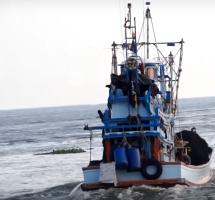 Overfishing is a huge problem in the world’s oceans. Exacerbating the problem is fishing piracy. A year ago, we posted “Can Big Data Stop Overfishing? Will Google’s Global Fishing Watch Succeed?” The post described how Oceana, SkyTruth and Google were launching Global Fishing Watch, a big-data technology platform that uses satellite data to create a tool for monitoring commercial fishing from a global perspective. The most recent version of this platform was launched in September. A similar project is a UK-funded initiative, Eyes on the Seas, developed by Satellite Applications Catapult (SAC) and the Pew Charitable Trusts. The idea is to give port officials the information that they need to identify pirate fishing vessels.
Overfishing is a huge problem in the world’s oceans. Exacerbating the problem is fishing piracy. A year ago, we posted “Can Big Data Stop Overfishing? Will Google’s Global Fishing Watch Succeed?” The post described how Oceana, SkyTruth and Google were launching Global Fishing Watch, a big-data technology platform that uses satellite data to create a tool for monitoring commercial fishing from a global perspective. The most recent version of this platform was launched in September. A similar project is a UK-funded initiative, Eyes on the Seas, developed by Satellite Applications Catapult (SAC) and the Pew Charitable Trusts. The idea is to give port officials the information that they need to identify pirate fishing vessels.
Technology alone won’t solve the problem. Even if satellites and data analysis can identify the pirate fishing vessels, someone still needs to enforce the catch limits. Fortunately a new treaty will help to do just that. The treaty, “The Agreement On Port State Measures To Prevent, Deter And Eliminate Illegal, Unreported And Unregulated Fishing“, is known as the Port State Measures Agreement (PSMA) was initiated by by the Food and Agricultural Organisation (FAO) and requires signatory countries to inspect or stop suspicious fishing vessels from entering their ports. The treaty took effect last June and now has 49 signatories.
Will the new treaty, satellite imagery and big-date tools end overfishing and the operation of pirate fishing vessels? Probably not, but they are a step in the right direction.
Fighting Illegal Fishing With New Satellite Tech—Inside Look

I signed-up to use it about 2 months ago, than the kept spaming me.